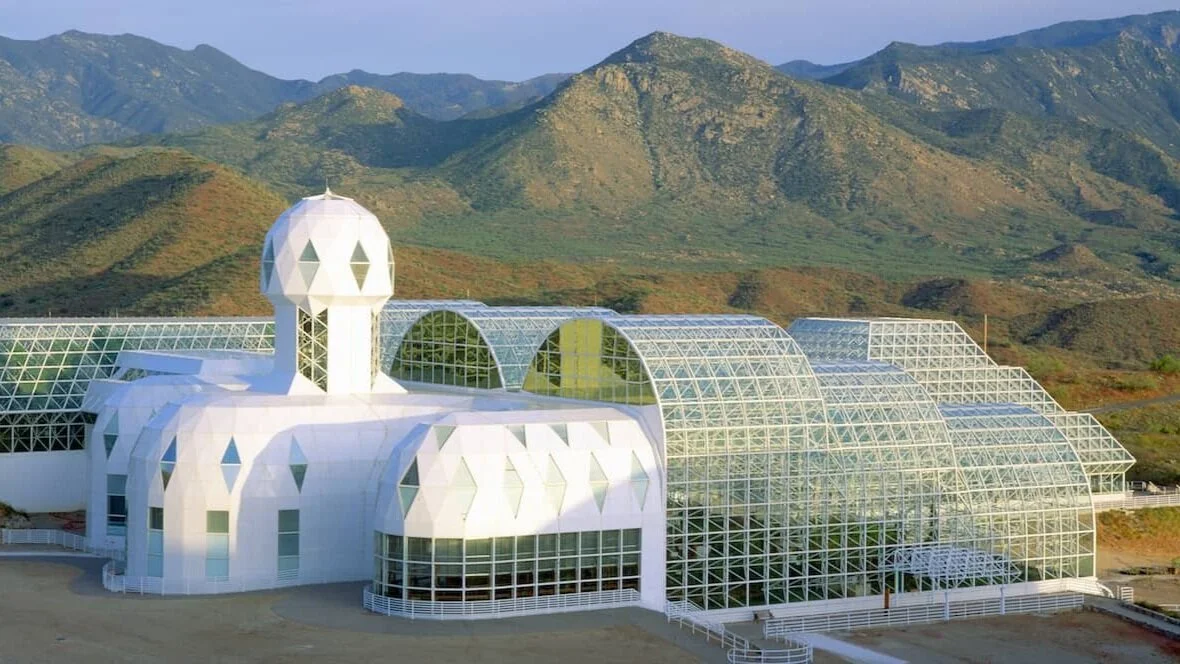Biosphere 2: Why Did it Fail?
Imagine a building that is a self-sustaining ecosystem replicative of our own planet Earth. This is the reality of Biosphere 2 in Southern Arizona, a 3-acre research facility in which an artificial world was created. Scientists recreated earth and life systems, including the desert, tundra, wetlands, and even a rainforest. The facility was created in the late eighties to research closed ecosystems in order to understand the implications of maintaining life in outer space, and whether Earth is actually substitutable.
The first experiment involved eight individuals who lived in the facility for two years. They would build a self-sustaining community by growing plants into food, while simultaneously conducting research on the three thousand species of flora and fauna present1 to better understand autonomous ecosystems. Machines would treat wastewater to simulate rainfall and mists, further advancing the case for technology to help sustain life in space.
The experiment soon started to show signs of trouble, however, as calibrating the ecosystem to mirror the exact conditions of the earth was a lot more complicated than expected. The 3 acres of space meant that 7 biome systems would interact with one another. The desert picked up condensation and became too wet. This changed the insect populations and increased plant cover, reducing photosynthesis. Oxygen levels declined from 20% to 14%1, which is equal to living at 15,000 feet, as atmospheric carbon dioxide and nitrous oxide levels rose. The scientists tried to plant trees to increase the oxygen levels, but the soil microbes produced carbon dioxide at a much faster rate. This resulted in higher rates of algal blooms in water bodies, which led to 30% of the species1, and all pollinators dying off. As the ecosystem broke down, the scientists had to spend more time trying to fix it, but it was evident that scaling down earth systems was not as simple as it seemed.
The ecological collapse in Biosphere 2 is reminiscent of the anthropogenic effects of climate change we are currently experiencing. As climate change effects start to show globally, human efforts to fight these changes will increase as we fail to adapt to hostile environments. Climate change is more than "hotter temperatures"; it is also soil depletion, acid rain, ocean acidification, and rising sea levels2. Ecology is multidisciplinary and requires an understanding of various complex systems.
Although Biosphere 2 is considered a failure, the lessons that we have learned about anthropogenic climate change are still relevant. It taught us that there is not a substitute for the earth systems we are degrading, and that society must move past the idea of "substitution optimism”. As we continue to decarbonize, we must understand that these actions do not prevent the current mass extinction — rather, multidisciplinary collaboration and strong leadership are key to solving these complex issues. Our current reliance on technological answers must be challenged, as solutions must find a balance between deep ecology, and ecomodernism, two extremes of climate action.
Written by Pranav Bhardwaj
Battistoni, Alyssa. “A Repair Manual for Spaceship Earth.” Logic: Nature, no. 9, 2019, pp. 219–37.
McKibben, Bill. “The Darkening Sea: What Carbon Emissions Are Doing to the Ocean.” The Global Warming Reader: A Century of Writing About Climate Change, edited by Elizabeth Kolbert, 1st ed., Penguin Books, 2012, pp. 377–98
Learn about our affordable carbon footprint solutions for small and medium-sized businesses
Book a free strategy session to discuss your climate goals with a sustainability manager.
About RyeStrategy
Based in Seattle, RyeStrategy is a CDP-accredited, mission-oriented company specialized in carbon accounting, mitigation coaching, and climate disclosure solutions for organizations at any point in their sustainability journey. Learn how RyeStrategy helped Salesforce, Ideascale, and Wazoku achieve their sustainability goals.
From exhaustive carbon footprinting and mitigation coaching, to setting science-based targets and reporting climate data to CDP, SBTi or custom reporting platforms, RyeStrategy acts as a hands-on extension of the team, custom-tailoring services to fulfill climate disclosure requirements easily and accurately.
Meet with a sustainability specialist to learn more about RyeStrategy solutions.

